Stunning Madaba Map: Oldest Known Mosaic Built Of Two Million Stone Cubes
A. Sutherland - AncientPages.com - The map of Madaba is the oldest known and existing geographic floor mosaic map of the Holy Lands in art history.
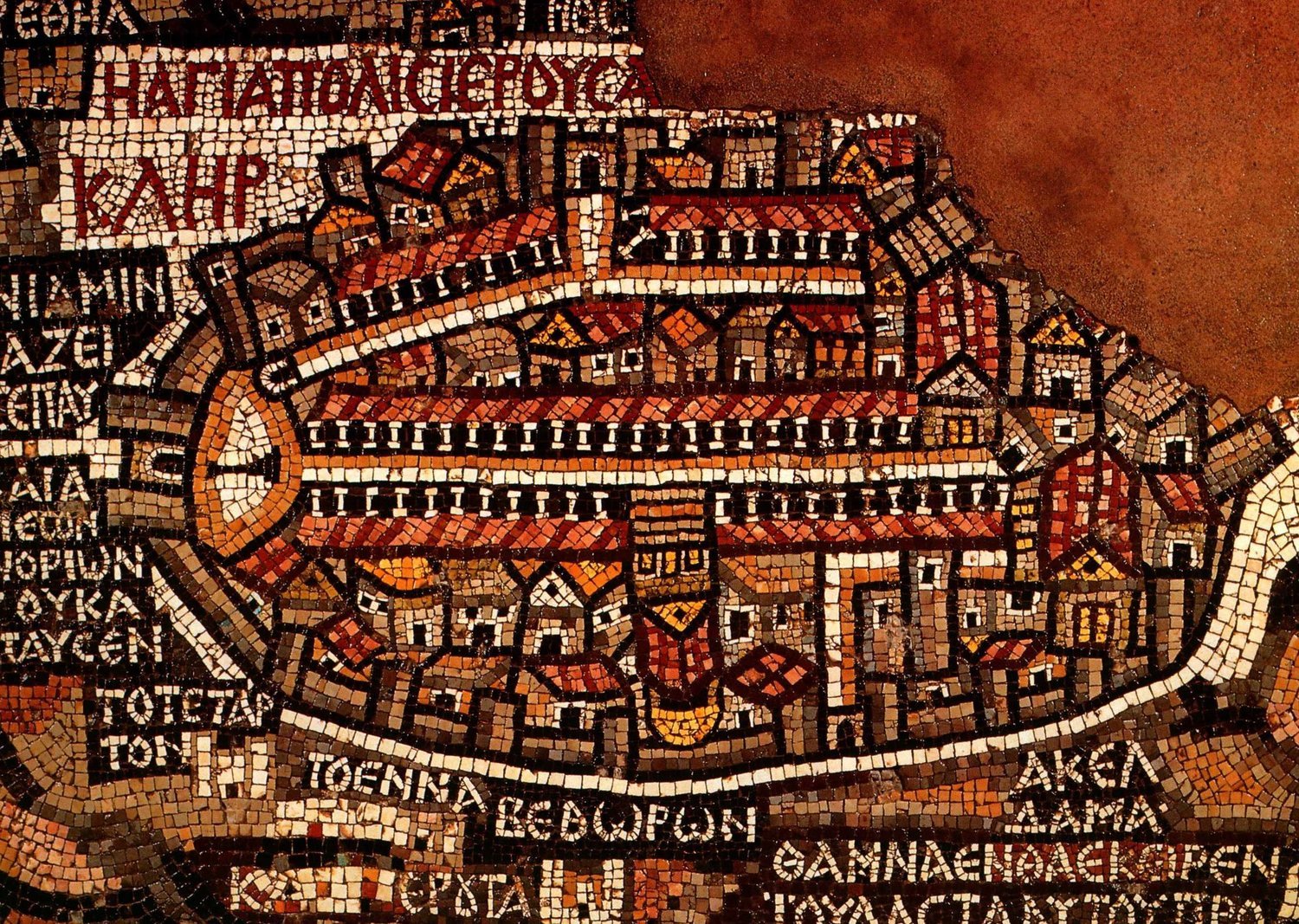 The fragment that depicts Jerusalem. Walls are visible around the big cities, including Jerusalem, Jericho, and Ashdod. Jerusalem is the focus of the map. The Madaba Map Centenary, 1897-1997 - Unknown author - Public Domain
The fragment that depicts Jerusalem. Walls are visible around the big cities, including Jerusalem, Jericho, and Ashdod. Jerusalem is the focus of the map. The Madaba Map Centenary, 1897-1997 - Unknown author - Public Domain
This beautiful and colorful work of ancient artists (or perhaps cartographers) who had both skills and biblical knowledge shows very accurate locations of the area, from Tyre in the north to the Egyptian Delta in the south, with all mountains, rivers, and the major cities.
The map that was created between 542 and 570 covers the floor of the Basilica of St. George in the city of Madaba ("the city of mosaics") in Jordan, about 15 miles southeast of the northern part of the Dead Sea.
The history of Madaba (mentioned in the Bible and on the Mesha Stele) goes back thousands of years. The first settlements in the area formed there in the 4th millennium BC. At the time of the Exodus and conquest, 1406 BC, Madaba, and Mt. Nebo were part of the territory of Moab. (Isa 15:2; Num 36:1; Deut 32:49.)
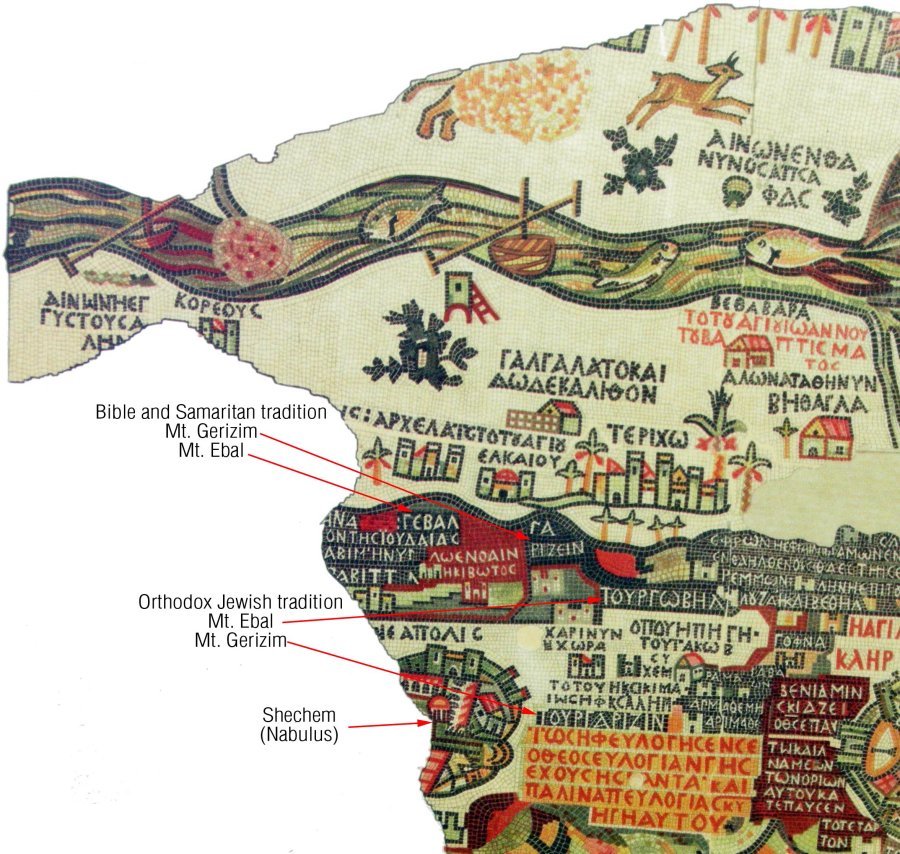 Madaba Map of Biblical Lands. Image credit: Bible ca.
Madaba Map of Biblical Lands. Image credit: Bible ca.
Taken by the Amorite king Sihon, which happened shortly before Joshua's conquest of Canaan, the Israelites passed through, took the city of Madaba, and conquered Sihon.
According to 1 Maccabees 9:32-42, Madaba was inhabited by a Nabataean tribe, the sons of Jambri, in the 2nd century BC.
Madaba had a long and turbulent history of being constantly captured by one enemy and passed back and forth from one conqueror to another.
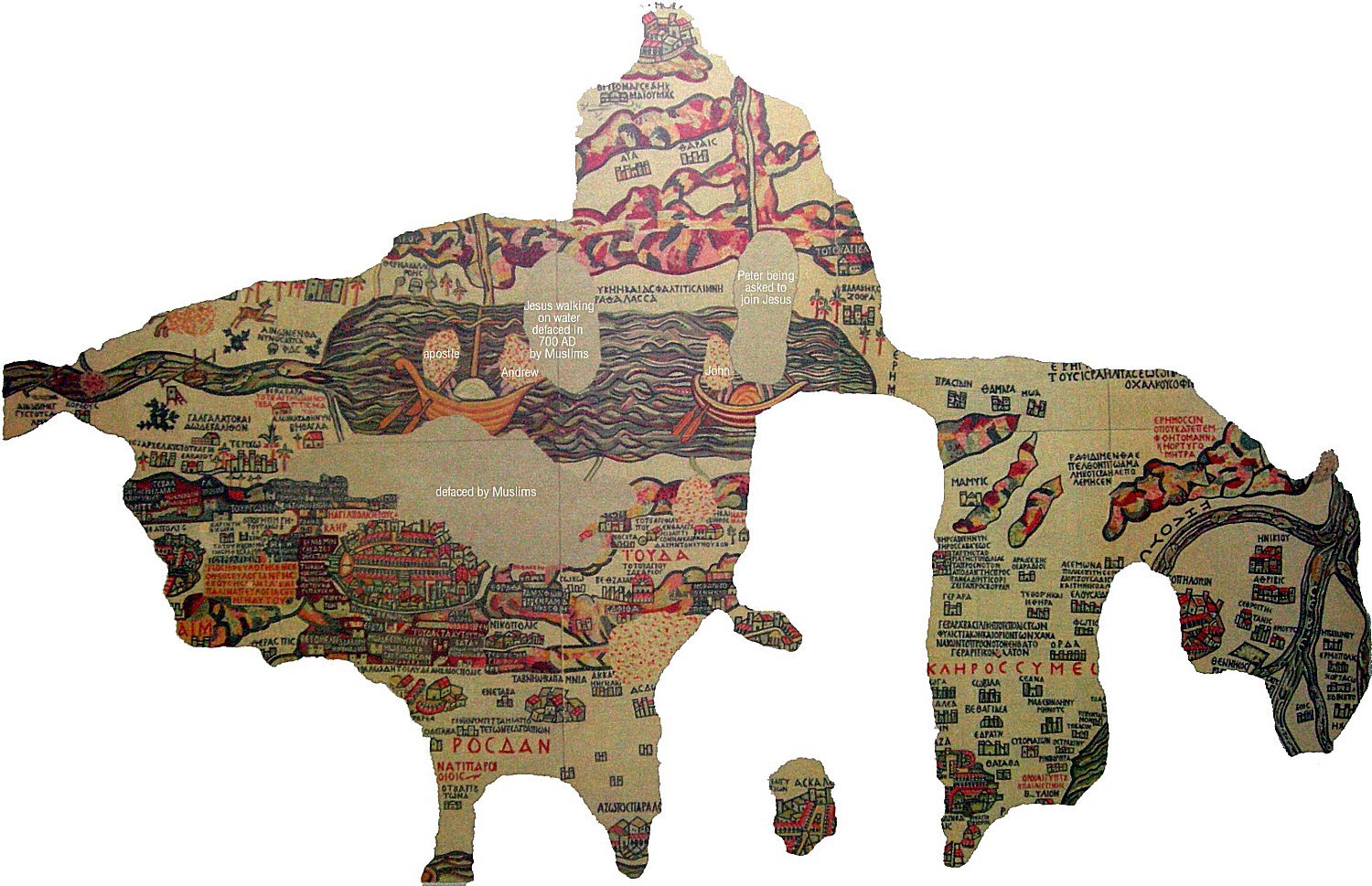 Madaba Map is considered by some scholars to be the best topographic representation ever done before modern cartography. Image credit: bible.ca
Madaba Map is considered by some scholars to be the best topographic representation ever done before modern cartography. Image credit: bible.ca
The map was initially created during the reign of emperor Justinian, 527-565 AD. It was formed of 2 million colored cubes and measured about 51 feet x 19.5 feet (15.5 m x 6 m).
The present remains of the map are composed of 750,000 cubes measuring 34.5 feet x 16.5 feet (10.5 m x 5 m and 150 Greek inscriptions in various sizes.
The most detailed element of the topographic depiction is Jerusalem, located at the center of the map. The anonymous artist accurately portrayed the old buildings of Jerusalem's Old Town, its gates, and some facilities, such as the Basilica of the Holy Sepulcher, Gethsemane, and the Citadel of David.
 Madaba Mosaic Map on the floor of the Basilica of St. George in the "city of of mosaics” in Jordan. Image credit: Visitpalestine.ps
Madaba Mosaic Map on the floor of the Basilica of St. George in the "city of of mosaics” in Jordan. Image credit: Visitpalestine.ps
Archaeological excavations conducted in 2010 further substantiated its accuracy with the discovery of a road depicted on the map that runs through the center of Jerusalem.
There are also clearly depictions of the Dead Sea, the bridges connecting the banks of the Jordan, river fish, and lions hunting gazelles on the Moab steppes, as well as cities, such as the Jericho palms and sacred places of Christians such as Bethlehem.
The mosaic was rediscovered in 1884 during the construction of a new Greek Orthodox church. In 1965-1966, the map was rediscovered and described by German archaeologists. All objects shown on the map are represented in Greek.
The unknown artists probably made the map for the Christian community of Madaba, which was the bishop's seat at that time. In 614, Madaba was conquered by the Sasanian Empire. In the eighth century, the ruling Muslim Umayyad Caliphate had some figural motifs removed from the mosaic.
Patriarch Nicodemus I of Jerusalem was informed about the incident, but no research was carried out until 1896 AD.
Unfortunately, large portions of the Madaba Map were damaged by fires and moisture effects that destroyed the art's quality. In 1965, major restoration works were undertaken to restore the remaining parts of the mosaic.
Written by – A. Sutherland - AncientPages.com Senior Staff Writer
Updated on September 29, 2022
Copyright © AncientPages.com All rights reserved. This material may not be published, broadcast, rewritten or redistributed in whole or part without the express written permission of AncientPages.com
Expand for referencesReferences:
Aa.Vv. The Mediterranean Medina: International Seminar
More From Ancient Pages
-
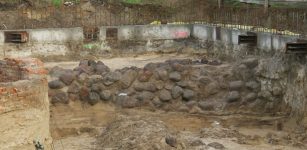 Massive Ancient Fortifications Reveal Poznan Was Poland’s First Capital
Archaeology | Jul 2, 2020
Massive Ancient Fortifications Reveal Poznan Was Poland’s First Capital
Archaeology | Jul 2, 2020 -
 Enigmatic Figure Dated Back To 40,000 From Prehistoric Stadel Cave, Germany
Ancient Traditions And Customs | Sep 7, 2018
Enigmatic Figure Dated Back To 40,000 From Prehistoric Stadel Cave, Germany
Ancient Traditions And Customs | Sep 7, 2018 -
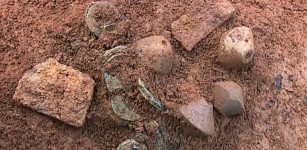 2,000-years-old tomb found in S. China
Archaeology | Apr 6, 2016
2,000-years-old tomb found in S. China
Archaeology | Apr 6, 2016 -
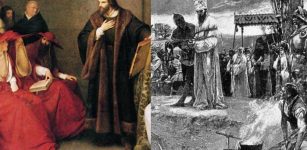 Jan Hus: Czech Reformer And Bohemian Religious Leader Was Burned At Stake For Heresy
Featured Stories | Dec 17, 2019
Jan Hus: Czech Reformer And Bohemian Religious Leader Was Burned At Stake For Heresy
Featured Stories | Dec 17, 2019 -
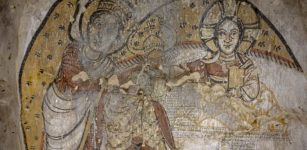 New, Unique Wall Paintings Discovered In Old Dongola, Sudan
Archaeology | Apr 10, 2023
New, Unique Wall Paintings Discovered In Old Dongola, Sudan
Archaeology | Apr 10, 2023 -
 Three Judges Of Souls Await You On Chinvat Bridge – Gateway To Unknown Realms In Zoroastrian Beliefs
Featured Stories | Aug 11, 2021
Three Judges Of Souls Await You On Chinvat Bridge – Gateway To Unknown Realms In Zoroastrian Beliefs
Featured Stories | Aug 11, 2021 -
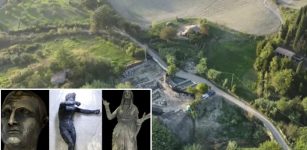 Incredible 2,300-Year-Old Roman-Etruscan Time Capsule Opened In San Casciano dei Bagni, Italy
Featured Stories | Dec 20, 2023
Incredible 2,300-Year-Old Roman-Etruscan Time Capsule Opened In San Casciano dei Bagni, Italy
Featured Stories | Dec 20, 2023 -
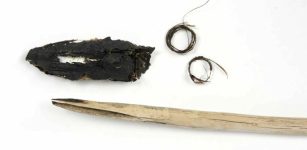 Surprising Discovery Of Unique 3,500- Year-Old Arrowheads Made Of Shells In The Jotunheimen Mountains
Archaeology | Feb 20, 2023
Surprising Discovery Of Unique 3,500- Year-Old Arrowheads Made Of Shells In The Jotunheimen Mountains
Archaeology | Feb 20, 2023 -
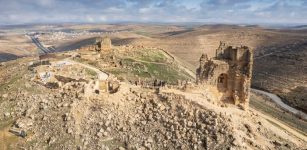 What Are The Huge Ancient Structures Beneath The Zerzevan Castle Discovered By Radar?
Archaeology | Sep 9, 2023
What Are The Huge Ancient Structures Beneath The Zerzevan Castle Discovered By Radar?
Archaeology | Sep 9, 2023 -
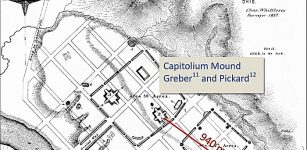 Archaeologists Refute Claims That A Comet Destroyed Hopewell Culture
Archaeology | Aug 11, 2023
Archaeologists Refute Claims That A Comet Destroyed Hopewell Culture
Archaeology | Aug 11, 2023 -
 Modern Humans Carrying The Neanderthal Variant Have Less Protection Against Oxidative Stress
Archaeology | Jan 6, 2022
Modern Humans Carrying The Neanderthal Variant Have Less Protection Against Oxidative Stress
Archaeology | Jan 6, 2022 -
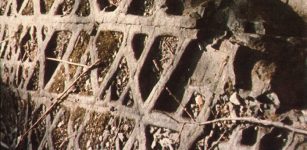 America’s Mysterious Waffle Rock Formation
Featured Stories | Apr 15, 2014
America’s Mysterious Waffle Rock Formation
Featured Stories | Apr 15, 2014 -
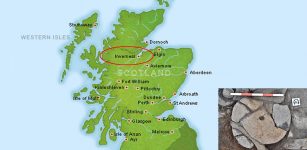 Mysterious Ancient Ruins Of Fortress Discovered In Scottish Highlands
Archaeology | Jan 16, 2018
Mysterious Ancient Ruins Of Fortress Discovered In Scottish Highlands
Archaeology | Jan 16, 2018 -
 How Did Hindu God Shiva Get His Third Eye?
Featured Stories | May 13, 2019
How Did Hindu God Shiva Get His Third Eye?
Featured Stories | May 13, 2019 -
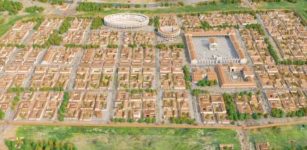 Stunning Reconstructions Shows What Colchester Looked Like During Roman Times
News | Jul 2, 2022
Stunning Reconstructions Shows What Colchester Looked Like During Roman Times
News | Jul 2, 2022 -
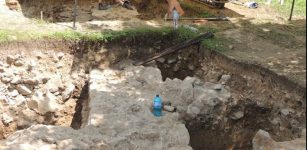 18th Century Potter Atmospheric Steam Engine Found In Slovakia
Archaeology | Jul 24, 2020
18th Century Potter Atmospheric Steam Engine Found In Slovakia
Archaeology | Jul 24, 2020 -
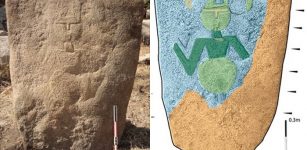 Unique Balchiria Stelae Engraved With A Goat-Like Figure Found On Corsica Is A Puzzle
Featured Stories | Feb 3, 2020
Unique Balchiria Stelae Engraved With A Goat-Like Figure Found On Corsica Is A Puzzle
Featured Stories | Feb 3, 2020 -
 Millennia-Old Sumerian Tripod Vase Dedicated To God Ningirsu, The Son OF Enlil
Archaeology | Oct 6, 2016
Millennia-Old Sumerian Tripod Vase Dedicated To God Ningirsu, The Son OF Enlil
Archaeology | Oct 6, 2016 -
 Andlang – Spiritual Heaven And Shelter For The Dead After Ragnarok In Norse Mythology
Featured Stories | Aug 23, 2019
Andlang – Spiritual Heaven And Shelter For The Dead After Ragnarok In Norse Mythology
Featured Stories | Aug 23, 2019 -
 Dingoes Given ‘Almost-Human’ Status In Pre-Colonial Australia – Archaeological Study Finds
Archaeology | Oct 21, 2023
Dingoes Given ‘Almost-Human’ Status In Pre-Colonial Australia – Archaeological Study Finds
Archaeology | Oct 21, 2023
